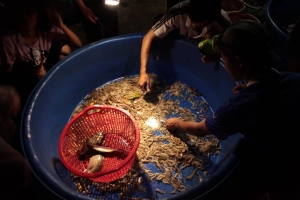Shrimping horizons
How shrimp farmers are saving thousands of miles of mangrove in Vietnam
Location: Viet Nam. 11th May 2017
Since the 1980s, a surge in shrimp farming has endangered mangroves around the world. Global growth has also increased the sector’s carbon dioxide emissions and exposed shorelines and coastal communities to erosion and storm surges.
During the past three decades, Vietnam has lost most of its mangroves, primarily due to the expansion of shrimp farming – a major contributor to Vietnam’s economy, generating USD 3.1 billion in export earnings in 2013 alone.
Vietnam is also highly vulnerable to rising sea levels and climate change, particularly in the low-lying Mekong Delta. Mangroves protect coastal regions against tidal waves and storm surges; they are vital fish nursery grounds; they provide timber, honey and other products; and they raise land levels by trapping sediment. They also sequester carbon faster than any other type of forest.

Vietnamese farmer examining the quality of his catch © Le Tien
The sustainability of the shrimp sector and the conservation of mangroves for coastal protection are therefore both national priorities.
To help the Vietnamese government address these competing priorities, IUCN and the Dutch NGO SNV Netherlands Development Organisation have implemented the Mangroves and Markets (MAM) project, funded by the International Climate Initiative, in Cà Mau to help shrimp farmers achieve organic certification under the Naturland label.
For more information and to read the full article published on the VIV Asia Digital magazine, please click here.

Shrimp farming in Viet Nam, Viet Nam © Ann Moey, 2017
Related Documents
Shrimping horizons
How shrimp farmers are saving thousands of miles of mangrove in Vietnam
Author: Ann Moey and Tony Watts
Publisher: VIV Asia Digital
Posted on: 11th May 2017
Category: MFF Country (NCB)
Size: 3.9 MB